Making multi-color designs on shirts and other fabrics with heat transfer vinyl is an inexpensive alternative to printing, whether it’s dye-sublimation or Joto paper, or solvent/latex on printable HTV.
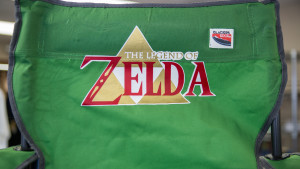
It’s pretty easy to do in the software (RazorCut allows you to separate cutting jobs by color in its spooling function) so you don’t have to switch out rolls of different-colored vinyl to do multiple jobs that contain the same color.
Siser EasyWeed (order NOW by the foot!) can be layered in different colors, with 3 or more layers posing no real problem in terms of difficulty or washability. In the first example shown here, we tried to make a hot fudge sundae decal. It works best for ease of registration to layer sequentially with solid-filled colors. First we chose our image, and then added a white outline around it. This solid-filled white outline became the base. Then we added the silver base and streaks (Siser Easyweed is very easy to register due to its see-through plastic backer-careful not to cut through it with too deep a blade setting), followed by the brown chocolate sauce, and lastly a cherry on top.
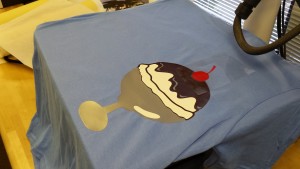
Each layer we pressed for 3 seconds at 320 degrees until the final layer, which received the whole 15 seconds.
For a softer layered look (layers within layers) we also tried the new Chemica DuoFlex (also available NOW by the foot in 4 styles!) which is a two-tone vinyl that shows an accented “outline” when pressed onto a shirt. It is very soft and flexible, making it easy to work with. Like Siser EasyWeed, you cut mirror, into the unfinished colored side. For a cleaner cut, you should choose the “Multi-Cut” feature in your software as it’s thicker and softer than most vinyl. Pressure should be set to light, heat to 320 degrees, for 20 seconds.
Note: If you go with a longer time and lower heat, the material appears to have even more dimensionality and softness of texture.
REMEMBER TO COLD PEEL!
In this other example, we show the results of layering DuoFlex onto a slightly larger blue EasyWeed base.
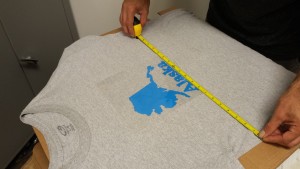
It can be a little harder to register, but notice the red and blue layers and the bright white on top that is washable again and again with a very soft hand for a very red-white-and-blue Alaskan experience.
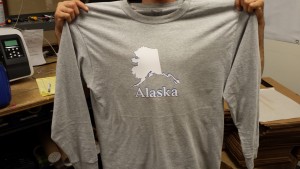
Not a big fan of white on top?
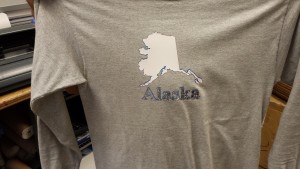
We followed up on the lettering with a strip of screen-printing foil all crinkled up to provide a distressed look, and as you can see that turned out very appealing as well.
These two experiments in heat transfer vinyl show, that if nothing else, there’s no end to the different effects and textures possible once you start piling on the layers.
